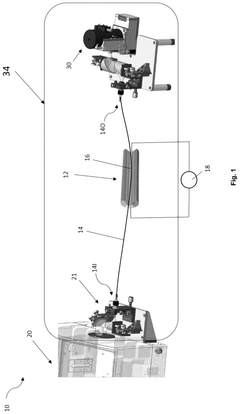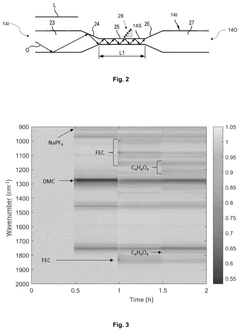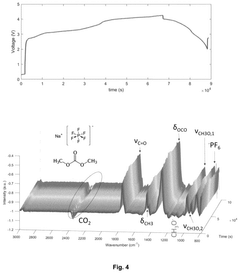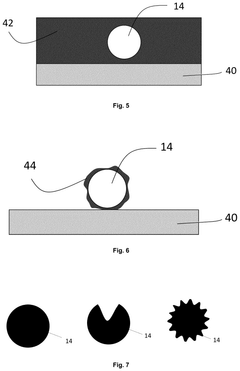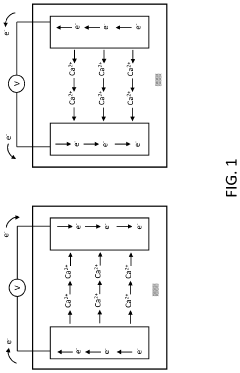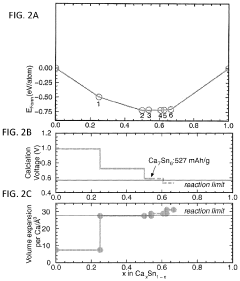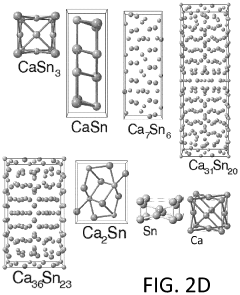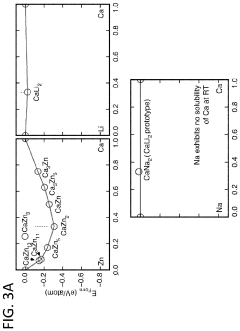Operando Characterization and Modeling Approaches for Calcium Ion Batteries
AUG 25, 20259 MIN READ
Generate Your Research Report Instantly with AI Agent
Patsnap Eureka helps you evaluate technical feasibility & market potential.
Calcium Ion Battery Technology Background and Objectives
Calcium ion batteries (CIBs) have emerged as a promising alternative to lithium-ion batteries due to the abundance of calcium resources, potentially higher energy density, and improved safety characteristics. The development of CIBs traces back to the early 1990s when initial investigations into calcium-based electrochemical systems began, though significant progress has only been achieved in the past decade with breakthroughs in electrolyte formulations and electrode materials.
The evolution of CIB technology has been marked by several key milestones, including the discovery of calcium metal plating/stripping in specific electrolytes at elevated temperatures (2015), the development of room-temperature calcium electrolytes (2017-2019), and recent advancements in cathode materials with reversible calcium intercalation properties. These developments have established a foundation for further research and potential commercialization.
Current technical objectives in the field focus on addressing fundamental challenges through operando characterization and modeling approaches. These techniques allow researchers to observe and understand calcium ion insertion/extraction mechanisms, interfacial phenomena, and degradation processes in real-time during battery operation. The integration of advanced characterization tools such as synchrotron-based X-ray techniques, neutron diffraction, and in-situ electron microscopy with computational modeling provides unprecedented insights into CIB functioning.
The primary goals of operando characterization include elucidating the calcium ion transport mechanisms across electrolyte-electrode interfaces, understanding structural changes in electrode materials during cycling, and identifying factors contributing to capacity fading and performance limitations. Complementary modeling approaches aim to predict material behaviors, optimize electrolyte compositions, and guide the design of next-generation CIB components.
Looking forward, the technology trajectory is expected to focus on developing multivalent battery systems that leverage calcium's divalent nature (Ca²⁺) to potentially achieve higher energy densities compared to monovalent lithium-ion systems. The anticipated evolution includes the development of novel electrolytes with wider electrochemical stability windows, cathode materials with enhanced calcium storage capabilities, and innovative cell designs optimized for calcium ion transport.
The ultimate objective of current research efforts is to establish CIBs as a viable commercial alternative to existing battery technologies, particularly for applications where high energy density, safety, and sustainability are paramount considerations. This requires overcoming significant scientific and engineering challenges through systematic investigation and innovative approaches to battery characterization and modeling.
The evolution of CIB technology has been marked by several key milestones, including the discovery of calcium metal plating/stripping in specific electrolytes at elevated temperatures (2015), the development of room-temperature calcium electrolytes (2017-2019), and recent advancements in cathode materials with reversible calcium intercalation properties. These developments have established a foundation for further research and potential commercialization.
Current technical objectives in the field focus on addressing fundamental challenges through operando characterization and modeling approaches. These techniques allow researchers to observe and understand calcium ion insertion/extraction mechanisms, interfacial phenomena, and degradation processes in real-time during battery operation. The integration of advanced characterization tools such as synchrotron-based X-ray techniques, neutron diffraction, and in-situ electron microscopy with computational modeling provides unprecedented insights into CIB functioning.
The primary goals of operando characterization include elucidating the calcium ion transport mechanisms across electrolyte-electrode interfaces, understanding structural changes in electrode materials during cycling, and identifying factors contributing to capacity fading and performance limitations. Complementary modeling approaches aim to predict material behaviors, optimize electrolyte compositions, and guide the design of next-generation CIB components.
Looking forward, the technology trajectory is expected to focus on developing multivalent battery systems that leverage calcium's divalent nature (Ca²⁺) to potentially achieve higher energy densities compared to monovalent lithium-ion systems. The anticipated evolution includes the development of novel electrolytes with wider electrochemical stability windows, cathode materials with enhanced calcium storage capabilities, and innovative cell designs optimized for calcium ion transport.
The ultimate objective of current research efforts is to establish CIBs as a viable commercial alternative to existing battery technologies, particularly for applications where high energy density, safety, and sustainability are paramount considerations. This requires overcoming significant scientific and engineering challenges through systematic investigation and innovative approaches to battery characterization and modeling.
Market Demand Analysis for Next-Generation Battery Technologies
The global energy storage market is witnessing unprecedented growth, driven by the increasing adoption of renewable energy sources and the electrification of transportation. Within this landscape, next-generation battery technologies are emerging as critical enablers for sustainable energy transition. Calcium ion batteries (CIBs) represent a promising alternative to conventional lithium-ion batteries, offering potential advantages in terms of cost, safety, and environmental impact due to calcium's abundance in the Earth's crust.
Market research indicates that the global advanced battery market is projected to grow substantially over the next decade, with particular interest in post-lithium technologies. The demand for calcium ion batteries is expected to increase significantly as industries seek more sustainable and cost-effective energy storage solutions. This growth is primarily driven by automotive applications, grid-scale energy storage, and consumer electronics sectors looking to overcome the limitations of current lithium-ion technology.
The automotive industry represents a major potential market for calcium ion batteries. With electric vehicle adoption accelerating worldwide, manufacturers are actively seeking battery technologies that offer higher energy density, faster charging capabilities, and lower production costs. Calcium ion batteries, with their theoretical capacity advantages and potential for rapid charging, align well with these requirements, positioning them as strong candidates for next-generation electric vehicles.
Grid-scale energy storage presents another substantial market opportunity. As renewable energy generation continues to expand globally, the need for efficient, long-duration energy storage solutions grows proportionally. Calcium ion batteries could address this need by offering longer cycle life and improved safety characteristics compared to current technologies, making them suitable for large-scale stationary applications.
Consumer electronics manufacturers are also showing interest in alternative battery chemistries that can deliver higher energy density and improved safety. The potential for calcium ion batteries to operate without thermal runaway issues makes them particularly attractive for wearable devices and portable electronics where safety is paramount.
Industrial applications represent an emerging market segment for calcium ion batteries. Manufacturing facilities, data centers, and telecommunications infrastructure require reliable backup power systems that can deliver high performance while minimizing maintenance requirements and safety risks. The inherent stability of calcium-based chemistries could provide significant advantages in these applications.
Despite the promising market outlook, commercial adoption faces challenges related to technology readiness. Current research efforts in operando characterization and modeling approaches are critical to accelerating the development timeline and bringing calcium ion batteries to market readiness, thereby unlocking their full commercial potential across these diverse application sectors.
Market research indicates that the global advanced battery market is projected to grow substantially over the next decade, with particular interest in post-lithium technologies. The demand for calcium ion batteries is expected to increase significantly as industries seek more sustainable and cost-effective energy storage solutions. This growth is primarily driven by automotive applications, grid-scale energy storage, and consumer electronics sectors looking to overcome the limitations of current lithium-ion technology.
The automotive industry represents a major potential market for calcium ion batteries. With electric vehicle adoption accelerating worldwide, manufacturers are actively seeking battery technologies that offer higher energy density, faster charging capabilities, and lower production costs. Calcium ion batteries, with their theoretical capacity advantages and potential for rapid charging, align well with these requirements, positioning them as strong candidates for next-generation electric vehicles.
Grid-scale energy storage presents another substantial market opportunity. As renewable energy generation continues to expand globally, the need for efficient, long-duration energy storage solutions grows proportionally. Calcium ion batteries could address this need by offering longer cycle life and improved safety characteristics compared to current technologies, making them suitable for large-scale stationary applications.
Consumer electronics manufacturers are also showing interest in alternative battery chemistries that can deliver higher energy density and improved safety. The potential for calcium ion batteries to operate without thermal runaway issues makes them particularly attractive for wearable devices and portable electronics where safety is paramount.
Industrial applications represent an emerging market segment for calcium ion batteries. Manufacturing facilities, data centers, and telecommunications infrastructure require reliable backup power systems that can deliver high performance while minimizing maintenance requirements and safety risks. The inherent stability of calcium-based chemistries could provide significant advantages in these applications.
Despite the promising market outlook, commercial adoption faces challenges related to technology readiness. Current research efforts in operando characterization and modeling approaches are critical to accelerating the development timeline and bringing calcium ion batteries to market readiness, thereby unlocking their full commercial potential across these diverse application sectors.
Current Status and Challenges in Operando Characterization
Operando characterization techniques for calcium ion batteries (CIBs) have seen significant advancement in recent years, yet remain considerably less developed compared to those for lithium-ion systems. Current state-of-the-art approaches primarily utilize synchrotron-based X-ray techniques, including X-ray diffraction (XRD), X-ray absorption spectroscopy (XAS), and X-ray tomography, which provide real-time insights into structural and chemical changes during battery operation.
Neutron-based techniques have emerged as complementary methods due to their sensitivity to light elements and ability to penetrate battery casings. However, access to neutron sources remains limited globally, restricting widespread application. Electron microscopy techniques, while offering nanoscale resolution, face significant challenges in maintaining operando conditions due to vacuum requirements and electron beam sensitivity of calcium-based materials.
A major technical challenge in operando characterization of CIBs is the development of specialized electrochemical cells compatible with various characterization techniques while maintaining realistic operating conditions. Current cell designs often compromise either electrochemical performance or measurement quality, creating a significant barrier to obtaining representative data.
The high reactivity of calcium metal and electrolytes presents additional challenges, as many operando setups struggle with proper sealing and environmental control. This often leads to parasitic reactions that complicate data interpretation and reduce measurement reliability. Furthermore, the slower kinetics of calcium ion transport compared to lithium necessitates longer measurement times, straining both equipment capabilities and beam time allocations at central facilities.
Data processing and interpretation represent another significant hurdle. The complex multiphase transformations and side reactions in CIB systems generate datasets that are difficult to deconvolute without advanced modeling approaches. Current software tools, largely developed for lithium systems, often fail to adequately address the unique characteristics of calcium electrochemistry.
Geographically, operando characterization capabilities for CIBs are concentrated in regions with major synchrotron facilities, particularly in Europe, North America, and East Asia. This creates disparities in research capabilities and slows global progress in the field. Collaborative networks are emerging to address this imbalance, but significant gaps remain in access to cutting-edge characterization techniques.
The integration of multiple complementary techniques (multi-modal characterization) represents the current frontier, with efforts to simultaneously track structural, chemical, and morphological changes during battery operation. However, such approaches require sophisticated instrumentation and data fusion methodologies that are still in early development stages for calcium systems.
Neutron-based techniques have emerged as complementary methods due to their sensitivity to light elements and ability to penetrate battery casings. However, access to neutron sources remains limited globally, restricting widespread application. Electron microscopy techniques, while offering nanoscale resolution, face significant challenges in maintaining operando conditions due to vacuum requirements and electron beam sensitivity of calcium-based materials.
A major technical challenge in operando characterization of CIBs is the development of specialized electrochemical cells compatible with various characterization techniques while maintaining realistic operating conditions. Current cell designs often compromise either electrochemical performance or measurement quality, creating a significant barrier to obtaining representative data.
The high reactivity of calcium metal and electrolytes presents additional challenges, as many operando setups struggle with proper sealing and environmental control. This often leads to parasitic reactions that complicate data interpretation and reduce measurement reliability. Furthermore, the slower kinetics of calcium ion transport compared to lithium necessitates longer measurement times, straining both equipment capabilities and beam time allocations at central facilities.
Data processing and interpretation represent another significant hurdle. The complex multiphase transformations and side reactions in CIB systems generate datasets that are difficult to deconvolute without advanced modeling approaches. Current software tools, largely developed for lithium systems, often fail to adequately address the unique characteristics of calcium electrochemistry.
Geographically, operando characterization capabilities for CIBs are concentrated in regions with major synchrotron facilities, particularly in Europe, North America, and East Asia. This creates disparities in research capabilities and slows global progress in the field. Collaborative networks are emerging to address this imbalance, but significant gaps remain in access to cutting-edge characterization techniques.
The integration of multiple complementary techniques (multi-modal characterization) represents the current frontier, with efforts to simultaneously track structural, chemical, and morphological changes during battery operation. However, such approaches require sophisticated instrumentation and data fusion methodologies that are still in early development stages for calcium systems.
State-of-the-Art Operando Characterization Techniques
01 Electrochemical characterization of calcium ion batteries
Various electrochemical techniques are used to characterize calcium ion batteries, including cyclic voltammetry, galvanostatic cycling, and impedance spectroscopy. These methods help evaluate the performance parameters such as capacity, cycling stability, rate capability, and coulombic efficiency. The characterization provides insights into the electrochemical reactions, ion diffusion kinetics, and interfacial processes occurring within calcium ion battery systems.- Electrochemical characterization of calcium ion batteries: Various electrochemical techniques are used to characterize calcium ion batteries, including cyclic voltammetry, galvanostatic cycling, and impedance spectroscopy. These methods help evaluate the performance parameters such as capacity, cycling stability, rate capability, and coulombic efficiency. The characterization provides insights into the electrochemical reactions, ion diffusion kinetics, and interfacial processes occurring within calcium ion battery systems.
- Modeling of calcium ion transport and diffusion mechanisms: Computational models are developed to simulate calcium ion transport and diffusion mechanisms within battery electrodes and electrolytes. These models incorporate parameters such as ion mobility, diffusion coefficients, and activation energies to predict ion movement across interfaces and through crystal structures. Advanced modeling approaches help understand the fundamental processes governing calcium ion insertion/extraction and identify rate-limiting steps in battery operation.
- Electrode material characterization for calcium ion batteries: Characterization of electrode materials for calcium ion batteries involves analyzing their structural, morphological, and compositional properties. Techniques such as X-ray diffraction, electron microscopy, and spectroscopic methods are employed to understand crystal structure, particle size, surface properties, and elemental distribution. These analyses help establish structure-property relationships and guide the development of high-performance electrode materials for calcium ion storage.
- Performance prediction and lifetime modeling of calcium batteries: Predictive models are developed to forecast the long-term performance and degradation behavior of calcium ion batteries. These models incorporate aging mechanisms, capacity fade factors, and failure modes to estimate battery lifetime under various operating conditions. Machine learning algorithms and physics-based approaches are combined to improve prediction accuracy and enable better battery management strategies for calcium-based energy storage systems.
- Multi-scale modeling approaches for calcium battery systems: Multi-scale modeling frameworks integrate atomic, molecular, and continuum-level simulations to provide comprehensive understanding of calcium ion battery behavior. These approaches bridge quantum mechanical calculations, molecular dynamics, and macroscopic models to capture phenomena occurring across different time and length scales. The integrated modeling strategy enables more accurate predictions of battery performance and guides the rational design of next-generation calcium-based energy storage technologies.
02 Modeling of calcium ion transport and diffusion mechanisms
Computational models are developed to understand calcium ion transport and diffusion mechanisms in battery materials. These models simulate the movement of calcium ions through electrolytes and electrode materials, predicting diffusion coefficients and activation energies. Advanced modeling approaches incorporate molecular dynamics simulations and density functional theory calculations to elucidate the fundamental processes governing calcium ion mobility in battery systems.Expand Specific Solutions03 Electrode material characterization for calcium ion batteries
Characterization of electrode materials for calcium ion batteries involves structural, morphological, and compositional analyses using techniques such as X-ray diffraction, electron microscopy, and spectroscopic methods. These analyses help understand the crystal structure, particle size, surface properties, and elemental distribution of electrode materials, which are crucial for optimizing battery performance. The characterization also reveals structural changes during calcium ion insertion/extraction processes.Expand Specific Solutions04 Electrolyte formulation and characterization for calcium batteries
Development and characterization of electrolytes for calcium ion batteries focus on identifying suitable solvents, salts, and additives that enable efficient calcium ion transport. Characterization techniques include conductivity measurements, viscosity testing, electrochemical stability window determination, and compatibility assessments with electrode materials. Novel electrolyte formulations aim to address challenges such as calcium plating/stripping efficiency and interfacial stability.Expand Specific Solutions05 Performance modeling and prediction of calcium ion battery systems
Comprehensive modeling approaches are developed to predict the performance of calcium ion battery systems under various operating conditions. These models integrate electrochemical, thermal, and mechanical aspects to simulate battery behavior during charging, discharging, and cycling. Machine learning algorithms and physics-based models are employed to predict battery lifetime, capacity fade mechanisms, and failure modes, enabling the design of more efficient and durable calcium ion batteries.Expand Specific Solutions
Leading Research Institutions and Industrial Players
Calcium ion batteries represent an emerging technology in the energy storage landscape, currently in the early development phase with a growing market potential due to calcium's abundance and safety advantages. The technology maturity remains relatively low, with significant research efforts focused on operando characterization and modeling approaches to overcome key challenges. Leading players in this field include academic institutions like Northwestern University, Tsinghua University, and Chinese Academy of Sciences, alongside industrial entities such as Toyota Motor Corp., A123 Systems, and Qnovo. Research collaborations between academic institutions (Commissariat à l'énergie atomique, CNRS) and commercial battery manufacturers are accelerating development, with particular focus on electrode materials, electrolyte formulations, and battery management systems to improve performance and cycle life.
Northwestern University
Technical Solution: Northwestern University has developed advanced operando characterization techniques for calcium ion batteries using synchrotron-based X-ray diffraction (XRD) and X-ray absorption spectroscopy (XAS) to monitor structural changes during battery cycling in real-time. Their approach combines multiple spectroscopic methods with electrochemical measurements to provide comprehensive insights into calcium ion insertion/extraction mechanisms. The research team has pioneered the use of hard X-ray photoelectron spectroscopy (HAXPES) for depth-profiling of electrode-electrolyte interfaces in calcium batteries, allowing for non-destructive analysis of the solid electrolyte interphase (SEI) formation. Additionally, they've developed computational models that correlate the spectroscopic data with electrochemical performance, enabling prediction of capacity fading mechanisms and optimization of electrode materials for enhanced cycling stability.
Strengths: Access to advanced synchrotron facilities and expertise in multiple characterization techniques provides comprehensive analysis capabilities. Their multi-modal approach offers deeper insights than single-technique methods. Weaknesses: The specialized equipment required limits widespread adoption, and the complex data analysis demands significant computational resources and expertise.
Uchicago Argonne LLC
Technical Solution: Argonne National Laboratory has developed a comprehensive operando characterization platform specifically for calcium ion batteries that integrates multiple analytical techniques. Their approach combines high-energy X-ray diffraction (HEXRD) with X-ray absorption near edge structure (XANES) and extended X-ray absorption fine structure (EXAFS) measurements at their Advanced Photon Source facility. This multi-modal approach allows simultaneous tracking of crystallographic changes, local atomic environments, and oxidation states during calcium ion insertion/extraction. Argonne has also pioneered specialized electrochemical cells for operando neutron diffraction studies, providing unique insights into calcium ion transport mechanisms. Their computational modeling framework incorporates density functional theory (DFT) calculations with machine learning algorithms to predict structural evolution and degradation pathways in calcium battery materials, enabling accelerated materials discovery and optimization.
Strengths: World-class facilities and multidisciplinary expertise enable comprehensive characterization across multiple length scales. Their integrated experimental-computational approach accelerates materials development. Weaknesses: The highly specialized infrastructure is not widely accessible, and the complex experimental setups can introduce artifacts that complicate data interpretation.
Key Scientific Breakthroughs in CIB Modeling Approaches
Method for operando characterization of chemical species within a battery using infrared evanescent wave spectroscopy
PatentPendingUS20250085214A1
Innovation
- The method involves inserting a chalcogenide glass optical fiber through a battery cell, generating and transmitting an infrared optical signal, and using evanescent wave spectrometry to detect and record the signal over time, allowing for the identification of signature wavelengths associated with specific chemical species within the SEI and electrolyte.
Calcium-metal alloy anode materials for reversible calcium-ion batteries
PatentActiveUS11901550B2
Innovation
- The use of intermetallic compounds comprising calcium and metals or metalloids such as Sb, As, Cu, Cd, Bi, Ag, Au, Pd, Pt, or Hg as anodes, paired with a calcium salt-based electrolyte and a cathode material like graphite, allowing for reversible decalcination and calcination reactions, and employing high-throughput density functional theory (DFT) calculations to identify suitable anode materials with high energy density and constrained volume expansion.
Environmental Impact and Sustainability Assessment
The environmental impact of calcium ion batteries represents a critical dimension in evaluating their viability as next-generation energy storage solutions. Compared to conventional lithium-ion technologies, calcium-based systems offer significant sustainability advantages due to calcium's greater natural abundance. Calcium ranks as the fifth most abundant element in Earth's crust at approximately 4.1% by weight, vastly exceeding lithium's 0.0017%. This abundance translates to reduced extraction pressures on fragile ecosystems and diminished geopolitical tensions surrounding resource acquisition.
Operando characterization methods enable real-time assessment of calcium battery performance under various environmental conditions, providing crucial data for lifecycle analysis. Recent studies utilizing synchrotron-based X-ray techniques have demonstrated that calcium-based electrodes generally exhibit lower toxicity profiles than their lithium counterparts, particularly regarding heavy metal contamination. However, challenges remain in quantifying the environmental footprint of electrolyte components, many of which contain fluorinated compounds with significant global warming potential.
Computational modeling approaches have advanced our understanding of calcium battery sustainability through predictive lifecycle assessments. Models incorporating material flow analysis suggest that transitioning from lithium to calcium technologies could reduce primary mining requirements by 35-40% for equivalent energy storage capacity. These models further indicate potential reductions in energy consumption during manufacturing processes, though validation through industrial-scale production remains pending.
Water usage represents another critical environmental consideration where operando characterization provides valuable insights. Unlike lithium extraction, which often depletes water resources in arid regions, calcium processing typically requires 60-70% less water per kilogram of active material. This advantage becomes particularly significant when modeling large-scale deployment scenarios for grid storage applications.
End-of-life management presents both challenges and opportunities for calcium battery technologies. Current recycling infrastructure designed for lithium-ion batteries requires adaptation for calcium-based chemistries. Preliminary modeling indicates that calcium compounds may be more readily recoverable through hydrometallurgical processes, potentially achieving recycling efficiency rates of 85-90% compared to 50-70% for conventional lithium-ion systems.
Carbon footprint analyses incorporating data from operando characterization suggest that calcium ion batteries could achieve 20-30% lower greenhouse gas emissions across their lifecycle compared to lithium-ion equivalents. This advantage stems primarily from reduced energy requirements during material extraction and processing, though manufacturing energy intensity remains comparable between technologies.
Operando characterization methods enable real-time assessment of calcium battery performance under various environmental conditions, providing crucial data for lifecycle analysis. Recent studies utilizing synchrotron-based X-ray techniques have demonstrated that calcium-based electrodes generally exhibit lower toxicity profiles than their lithium counterparts, particularly regarding heavy metal contamination. However, challenges remain in quantifying the environmental footprint of electrolyte components, many of which contain fluorinated compounds with significant global warming potential.
Computational modeling approaches have advanced our understanding of calcium battery sustainability through predictive lifecycle assessments. Models incorporating material flow analysis suggest that transitioning from lithium to calcium technologies could reduce primary mining requirements by 35-40% for equivalent energy storage capacity. These models further indicate potential reductions in energy consumption during manufacturing processes, though validation through industrial-scale production remains pending.
Water usage represents another critical environmental consideration where operando characterization provides valuable insights. Unlike lithium extraction, which often depletes water resources in arid regions, calcium processing typically requires 60-70% less water per kilogram of active material. This advantage becomes particularly significant when modeling large-scale deployment scenarios for grid storage applications.
End-of-life management presents both challenges and opportunities for calcium battery technologies. Current recycling infrastructure designed for lithium-ion batteries requires adaptation for calcium-based chemistries. Preliminary modeling indicates that calcium compounds may be more readily recoverable through hydrometallurgical processes, potentially achieving recycling efficiency rates of 85-90% compared to 50-70% for conventional lithium-ion systems.
Carbon footprint analyses incorporating data from operando characterization suggest that calcium ion batteries could achieve 20-30% lower greenhouse gas emissions across their lifecycle compared to lithium-ion equivalents. This advantage stems primarily from reduced energy requirements during material extraction and processing, though manufacturing energy intensity remains comparable between technologies.
Standardization and Validation Methodologies
The standardization and validation of operando characterization and modeling approaches for calcium ion batteries (CIBs) represent critical challenges in advancing this promising energy storage technology. Currently, the field lacks universally accepted protocols for testing and validating CIB performance, creating significant barriers to meaningful comparison of research results across different laboratories and institutions.
Establishing standardized testing protocols is essential for the reliable assessment of calcium ion battery components and systems. These protocols should encompass electrode preparation methods, electrolyte formulations, cell assembly procedures, and testing conditions including temperature ranges, current densities, and cycling parameters. The development of reference materials and benchmark systems would provide valuable calibration points for researchers worldwide, enabling more consistent evaluation of novel materials and designs.
Validation methodologies for operando characterization techniques require particular attention due to the complex nature of calcium electrochemistry. X-ray diffraction (XRD), X-ray absorption spectroscopy (XAS), and neutron diffraction techniques used for in-situ monitoring of structural changes during calcium insertion/extraction processes need standardized data collection and analysis procedures. Similarly, electrochemical techniques such as cyclic voltammetry and impedance spectroscopy require consistent implementation and interpretation frameworks.
For computational modeling approaches, validation against experimental data is paramount. This necessitates the development of standardized datasets that can serve as benchmarks for theoretical predictions. Round-robin testing involving multiple research groups can help establish the reproducibility and reliability of both experimental and computational methodologies, fostering greater confidence in reported results.
International collaboration through organizations such as the International Electrotechnical Commission (IEC) and the International Organization for Standardization (ISO) could accelerate the establishment of globally recognized standards for CIB research and development. Industry participation in these standardization efforts would ensure that academic research aligns with practical application requirements.
The creation of open-access databases containing validated experimental and computational results would significantly benefit the research community. Such resources would facilitate meta-analyses and accelerate the identification of promising research directions, ultimately expediting the commercialization timeline for calcium ion battery technology.
Addressing these standardization and validation challenges requires coordinated effort across the research community but would yield substantial benefits in terms of research efficiency, reproducibility, and technological advancement in the calcium ion battery field.
Establishing standardized testing protocols is essential for the reliable assessment of calcium ion battery components and systems. These protocols should encompass electrode preparation methods, electrolyte formulations, cell assembly procedures, and testing conditions including temperature ranges, current densities, and cycling parameters. The development of reference materials and benchmark systems would provide valuable calibration points for researchers worldwide, enabling more consistent evaluation of novel materials and designs.
Validation methodologies for operando characterization techniques require particular attention due to the complex nature of calcium electrochemistry. X-ray diffraction (XRD), X-ray absorption spectroscopy (XAS), and neutron diffraction techniques used for in-situ monitoring of structural changes during calcium insertion/extraction processes need standardized data collection and analysis procedures. Similarly, electrochemical techniques such as cyclic voltammetry and impedance spectroscopy require consistent implementation and interpretation frameworks.
For computational modeling approaches, validation against experimental data is paramount. This necessitates the development of standardized datasets that can serve as benchmarks for theoretical predictions. Round-robin testing involving multiple research groups can help establish the reproducibility and reliability of both experimental and computational methodologies, fostering greater confidence in reported results.
International collaboration through organizations such as the International Electrotechnical Commission (IEC) and the International Organization for Standardization (ISO) could accelerate the establishment of globally recognized standards for CIB research and development. Industry participation in these standardization efforts would ensure that academic research aligns with practical application requirements.
The creation of open-access databases containing validated experimental and computational results would significantly benefit the research community. Such resources would facilitate meta-analyses and accelerate the identification of promising research directions, ultimately expediting the commercialization timeline for calcium ion battery technology.
Addressing these standardization and validation challenges requires coordinated effort across the research community but would yield substantial benefits in terms of research efficiency, reproducibility, and technological advancement in the calcium ion battery field.
Unlock deeper insights with Patsnap Eureka Quick Research — get a full tech report to explore trends and direct your research. Try now!
Generate Your Research Report Instantly with AI Agent
Supercharge your innovation with Patsnap Eureka AI Agent Platform!
